Magnetism in the Earth’s mantle, impressive asteroid observations, and insights into influenza Understand article
Science in School is published by EIROforum, a collaboration between eight of Europe’s largest intergovernmental scientific research organisations (EIROs). This article reviews some of the latest news from the EIROs.
CERN: Students investigate fundamental physics with beamline competition
Earlier this year, CERN invited high-school students from across the world to submit proposals for their sixth Beamline for Schools competition, which gives students the opportunity to run their own experiment using a fully equipped beamline. More than 60 experts from CERN and the Deutsches Elektronen-Synchrotron (DESY) research centre evaluated the 178 proposals. The two winning teams – one from Groningen, Netherlands, and one from Salt Lake City, USA – were announced in June.
There are currently no beamlines in use at CERN, due to the shutdown of CERN’s particle accelerators for maintenance and upgrades, so instead the two teams were invited to DESY in Hamburg, Germany. They will carry out their experiments, both of which involve investigating the fundamental differences between matter and antimatter, on the DESY beamline.
Learn more about the 2019 winning teams and their experiment proposals on the CERN website.
The CERN laboratory sits astride the Franco-Swiss border near Geneva, Switzerland. It is the world’s largest particle physics laboratory.
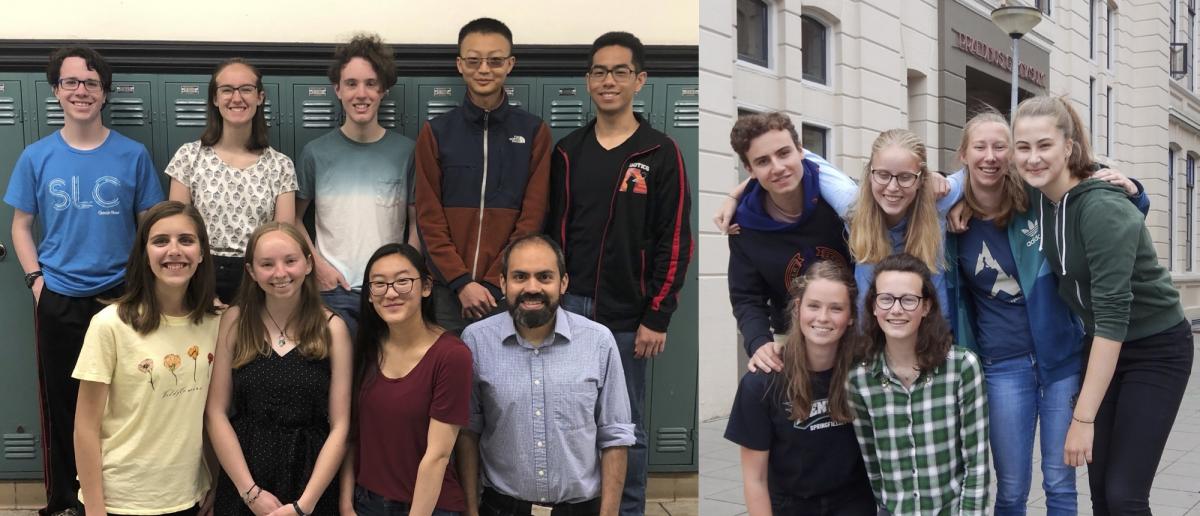
Left image: Kara Budge/CERN; Right image: Martin Mug/CERN
EMBL: Paving the way for new flu drugs
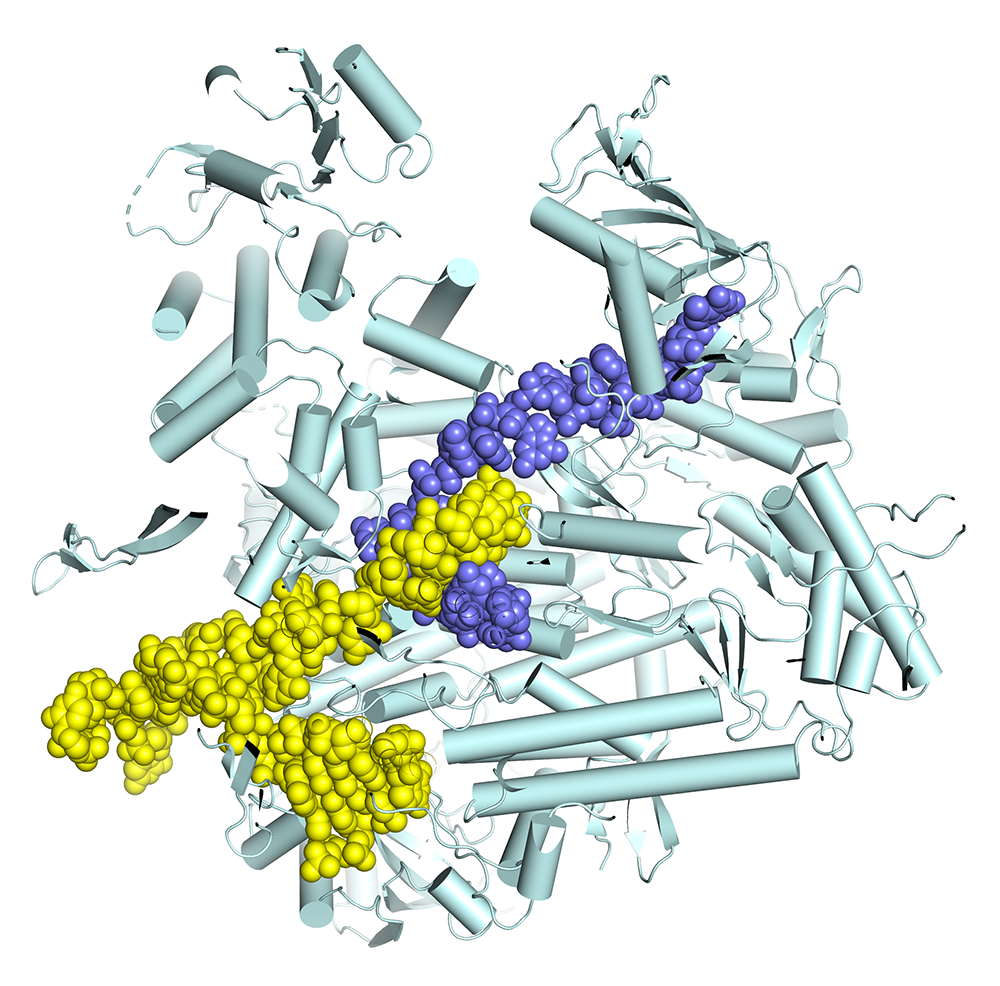
blue) in the process of
synthesising messenger RNA
(purple) by copying the viral
RNA (yellow)
Stephen Cusack/EMBL
Up to 500 000 people worldwide die from influenza each year, and mortality rates are potentially much higher when a new pandemic flu strain emerges. Vaccination is not always effective, and anti-influenza drugs are needed as a complementary treatment option.
To design the next generation of anti-influenza drugs, scientists must understand the genetic processes of transcription and replication of the viral genome. These processes are carried out by an enzyme called a polymerase. Such enzymes are crucial to the propagation of the virus, as they allow the host cell to be tricked into making viral proteins and copies of the viral genome, thus producing more viruses to infect new hosts.
For the first time, scientists at the European Molecular Biology Laboratory (EMBL) in Grenoble, France, have observed the different states of the influenza virus polymerase in action. A drug that stops the polymerase from functioning would be much less likely to be affected by mutations of the virus, which is a problem for existing drugs.
Learn more about the study by visiting the EMBL website.
EMBL is Europe’s leading laboratory for basic research in molecular biology, with its headquarters in Heidelberg, Germany.
ESA: Space science challenges for the new school year
Each academic year, the European Space Agency (ESA) launches a series of exciting challenges for schools. The challenges cover a range of school subjects and are suitable for a variety of age groups. In the 2019/2020 academic year, ESA will offer five challenges for students to get involved in.
Among these projects are the European CanSat Competition and Mission X. The CanSat Competition invites students to build and test a CanSat – a simulation of a real satellite that is no larger than a soft-drink can and is launched to an altitude of a few hundred metres using a rocket or balloon. Mission X is an international educational challenge focusing on health and nutrition that encourages students to train like an astronaut. Students practice scientific reasoning and teamwork whilst participating in hands-on training missions.
Also on offer are the European Astro Pi Challenge, Moon Camp Challenge and Climate Detectives. You can find out more about all the challenges and how your students can participate by visiting the ESA Education webpage.
Information for all ESA Education programmes can be found on the ESA website.
ESA is Europe’s gateway to space, with its headquarters in Paris, France.

ESA
ESO: Tracking asteroids with the Very Large Telescope
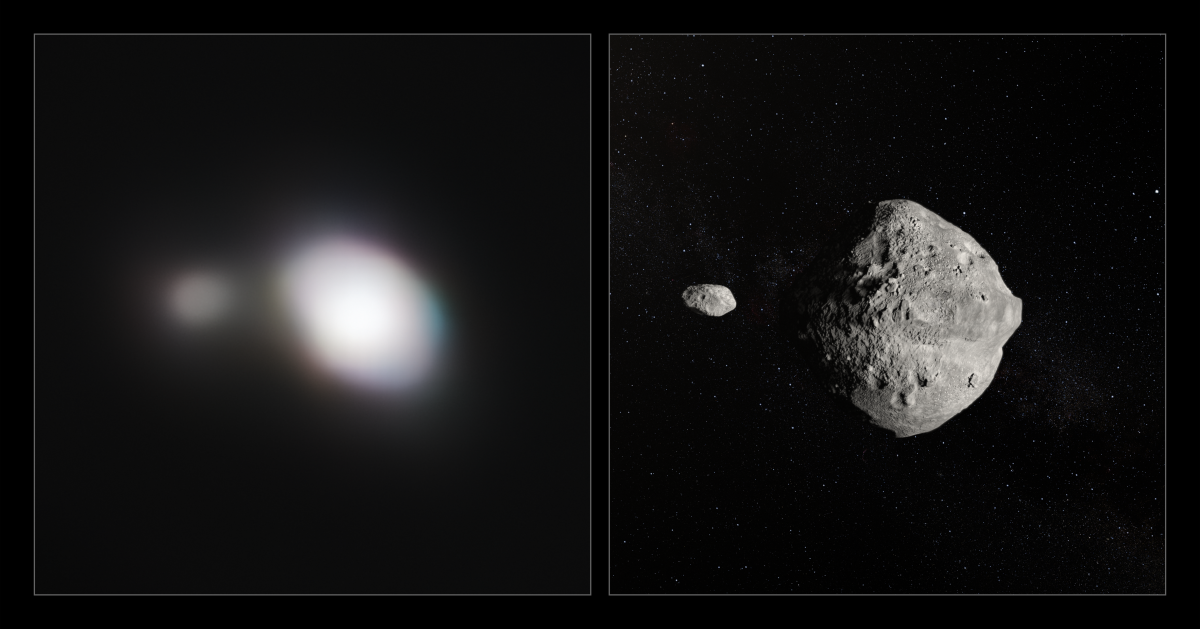
the observation (left) and an
artist’s impression (right) of
asteroid 1999 KW4
ESO
The biggest telescopes on Earth usually observe astronomical objects millions of light years away. But on 25 May 2019, the Very Large Telescope (VLT) of the European Southern Observatory (ESO) focused on an object much closer to Earth: a double asteroid flying only 17 light seconds away, some 5.2 million kilometres from Earth (about 7% of the minimum distance between Earth and Mars).
The images from the VLT are the sharpest ever obtained of a double asteroid. This is thanks to the unique capabilities of the VLT’s powerful detector, which uses an adaptive optics system to correct for the distortion effects caused by Earth’s turbulent atmosphere.
Although the double asteroid, named 1999 KW4, did not pose a threat to Earth, scientists used this opportunity to test the VLT’s capability in tracking such an object travelling at a speed of 70 000 km/h. The success of this test shows that ground-based telescopes equipped with sophisticated detectors could be critical in tracking nearby asteroids in the future, to keep Earth safe.
Learn more about the observation of 1999 KW4 by visiting the ESO website.
ESO is the foremost intergovernmental astronomy organisation in Europe and the world’s most productive ground-based astronomical observatory, with its headquarters in Garching, near Munich in Germany, and its telescopes in Chile.
ESRF: Scientists discover magnetism in Earth’s mantle
We know that the Earth’s magnetic field is derived from its core and crust, but it was also thought that the Earth’s mantle (50–2500 m below the surface) was non-magnetic. This is because the conditions of extreme heat and pressure within the mantle were thought to cause the mineral haematite (a common iron oxide found in the mantle) to lose its magnetism. However, recent magnetic satellite data suggests that parts of the mantle are magnetic, particularly around cooler areas such as tectonic plate boundaries.
Now, a team of researchers has helped to explain these magnetic anomalies by exposing a sample of haematite to conditions similar to those in the mantle itself. Using the beamline ID18 at the European Synchrotron Radiation Facility (ESRF), the researchers were surprised to find that the haematite remained magnetic up to the temperatures and pressures found at the transition zone between the upper and lower mantle. Scientists are now considering whether the magnetic anomalies, particularly those found beneath the Western Pacific Ocean, could be due to the presence of magnetic iron oxide in the mantle in such locations.
To learn more about the study, visit the ESRF website.
Situated in Grenoble, France, ESRF operates the most powerful synchrotron radiation source in Europe.
Pierre Jayet/ESRF
EUROfusion: Fusion spin-off for cancer diagnosis
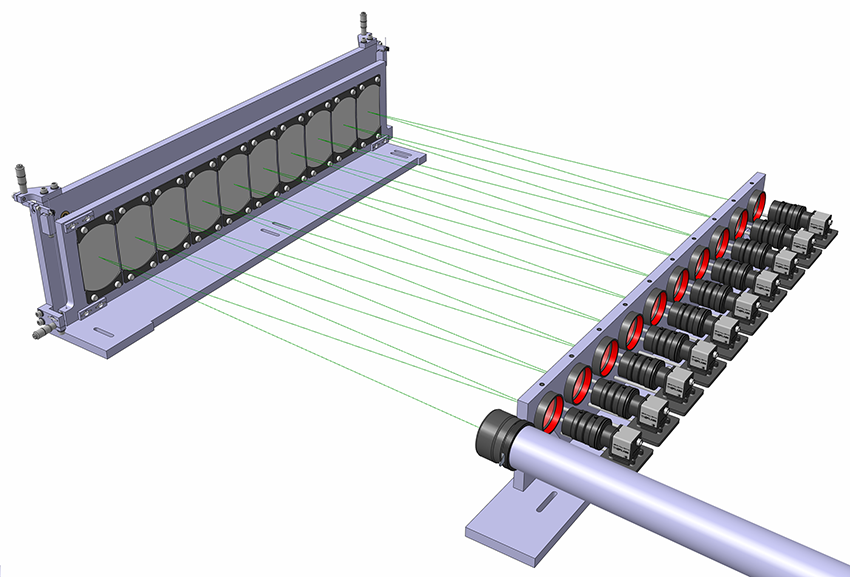
system developed by Dr
Wouter Vijvers at DIFFER,
which will be adapted by
Chromodynamics to diagnose
and remove cancerous
tumours
DIFFER
When it comes to cancer, improving early diagnosis is key to saving lives. To help achieve this goal, a former fusion researcher recently founded a spin-off company to explore the potential of multispectral imaging in cancer diagnosis.
The imaging technique is based on the research of the company’s founder and CEO, Wouter Vijvers, at two EUROfusion consortium members: the Dutch Institute for Fundamental Energy Research (DIFFER) and the Swiss Plasma Center (SPC). Wouter developed his novel multispectral imaging and diagnostic system to study parts of fusion plasmas. Now, he aims to adapt this technique for medical and industrial applications. One of the main long-term goals of the new company, Chromodynamics, is to provide a single step solution for diagnosing and removing cancerous tumours.
Healthy and malignant tissues have different chemical profiles, and multispectral imaging will be able to capture this difference in real time. Surgeons will thus be able to use the multispectral image while operating to ensure that a tumour is completely removed.
Learn more about the multispectral imaging system on the EUROfusion website.
EUROfusion manages and funds European fusion research activities, with the aim of realising fusion electricity. The consortium comprises 30 members from 26 European Union countries as well as Switzerland and Ukraine.
European XFEL: Getting the timing right for molecular movies
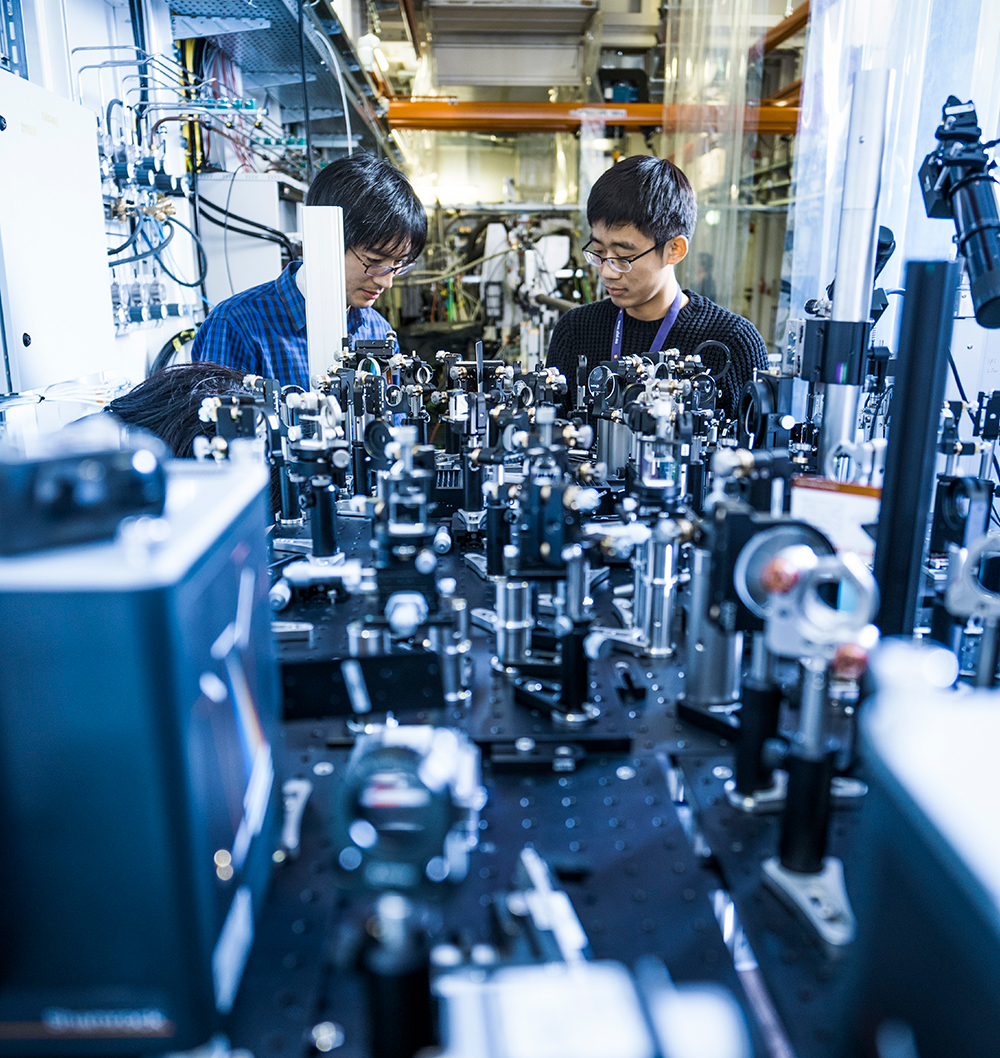
jitter of the SPB/SFX
experiment station at
European XFEL
Jan Hosan/European XFEL
Chemical reactions are extremely fast. To watch them happen, scientists use intense pulses of laser light at X-ray facilities such as the European X-ray Free-Electron Laser (European XFEL). Researchers kick-start the reaction by shining an optical laser on the sample, before using the ultrashort X-ray laser pulses to take a sequence of images showing the molecular process. The images are then stitched together to create a movie.
To get the timing of the individual snapshots of the movie just right, scientists need to understand the timing variation, or ‘jitter’, of the two laser beams used to take the images. Even the slightest timing delay or variation in the experiment set-up can counteract the benefits of using the ultrashort X-ray pulses in the first place.
In a recent experiment, scientists at European XFEL measured the jitter at the SPB/SFX instrument and found a value of 308 femtoseconds (10-15 s) for this undesirable effect. Scientists now expect to significantly reduce the delay as upgrades are made to the facility.
Read more about this measurement at the European XFEL website.
European XFEL is a research facility in the Hamburg area of Germany. Its extremely intense X-ray flashes are used by researchers from all over the world.
ILL: Ionisation potential of promethium determined after 75 years
An important characteristic of any chemical element is its ionisation potential, which represents the energy required to remove one electron from a neutral atom. Over the years, the ionisation potentials of all chemical elements from hydrogen (element 1) to lawrencium (element 103) have been experimentally determined, with one exception: promethium (element 61).
Now, nearly 75 years after its discovery, a European collaboration of chemists and physicists have published the ionisation potential for this element, thus closing the last remaining gap in the periodic table for this fundamental property.
One of the reasons why this task was particularly difficult is that promethium is a very rare element with no stable isotopes. To tackle this challenge, scientists used the high-flux reactor at the Institut Laue-Langevin (ILL) to artificially produce a long-lived isotope of promethium, Pm-147. Using atomic spectroscopy, the scientists determined that the ionisation potential of promethium is 5.58188 electron volts (eV).
Read more about this study on the ILL website.
Based in Grenoble, France, ILL is an international research centre at the leading edge of neutron science and technology.
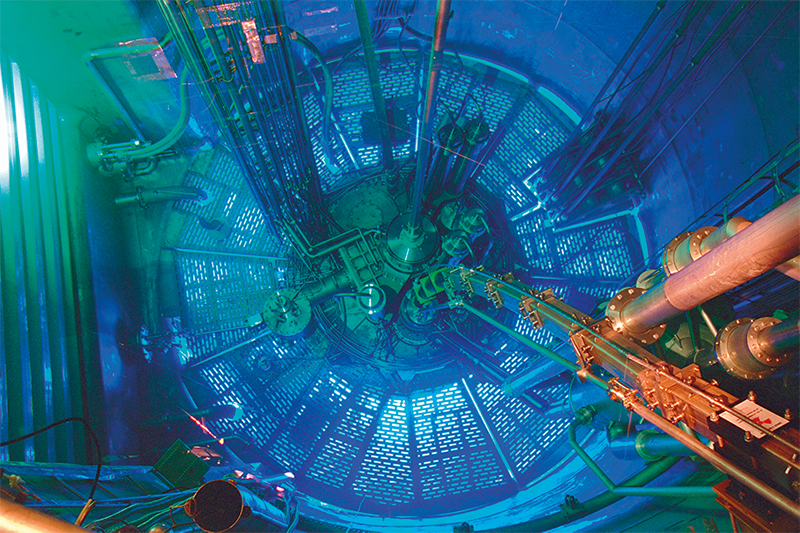
Jean-Luc Baudet/ILL
EIROforum
EIROforum combines the resources, facilities and expertise of its member organisations to support European science in reaching its full potential.
To learn more, see also the list of EIROforum-related articles in Science in School or browse the other EIRO news articles.






